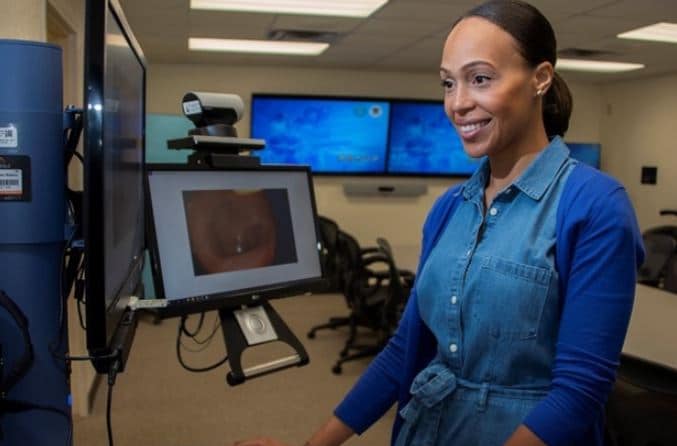by Sophie Brice, PhD
Crazy Covid Times. That’s what I’ve come to call this weird, challenging new era we find ourselves in. My career pathway gives me a unique understanding of the challenges of overcoming the COVID virus itself and the lifestyle implications for our communities. I’ve always been led by an interest in health and helping people overcome illness.
In my first career as a scientist, I worked on vaccine design for a stubborn virus. I eventually left the labs to work in a role delivering hearing healthcare using Telehealth. In my role delivering Teleaudiology services with Blamey Saunders hears I work to address or support any part of a person’s hearing needs no matter what their circumstance or lifestyle they have to work with or around.
Hearing in isolation
Right now, the whole world is experiencing a taste of isolation and the impacts of not being able to access services in the way they’re used to. This mimics the barriers to hearing care, straightforward and not so obvious, that telemedicine seeks to solve.
When Blamey Saunders hears created a new way to access hearing care almost a decade ago they did so by offering a self-fit hearing aid range that can be supported by a mix of online and clinic services available interchangeably. The arrival of OTC in America and a recent catch up by all major manufacturers in hearing care to make parts of the hearing care journey accessible by remote delivery are positive and practical steps forward. The growth and variation of types of hearing devices from almost exclusively hearing aids to a plethora of hearables also opens opportunities for consumers to address their needs in a way that suits their lifestyle needs and priorities.
With more self-fit devices joining the market, for example, an online-only device called SHIFT coming from Australia, this approach has continued to allow a way forward for the modern worker, the rurally out of reach, housebound, those in care, or abroad, or where there is no local services.
The accompanying Teleaudiology services makes it possible for those who otherwise cannot, or will not, access hearing care to be supported in a manner that works for them at a pace they can choose. Allowing the person to be in the centre of care is crucial in breaking down barriers and right now, it has become more important than ever.
Teleaudiology is a Tool to Help
Before these Crazy Covid Times inflicted restrictions on how we work, travel, communicate and complete our daily obligations, Tele-services were gaining recognition as a practical and economical solution for the health care provider and end user. A rethink of business models, such as unbundling and blended services, allowed a reduction in costs that is passed down to the consumer.
Over the years of developing and delivering Teleaudiology services, we have refined our understanding of the specialist skill set required to deliver effective remote client coaching and support. This has produced a new understanding of what true client engagement means and really looks like as a Teleaudiologist has the unique privilege of “being” inside someone’s home – often with their family.
Specialist training and education will eventually be needed to hone these skills inside a multi-disciplinary workforce. The transition from seeing a client face-to-face in a clinic to dealing with them in a new way where the core goal is to coach and support them to self-manage is somewhat of a behaviour reset and expansion of skills for many hearing care professionals.
Flexible communication is key
Online service offerings have faced a fair amount of resistance and skepticism from the industry over the years. However, it is in these Crazy Covid Times that the needs that created these business models in the first place come to light and there is a greater understanding of why they should be taken seriously.
Having been the person who assists and helps hearing aid users remotely, whether they be one suburb away on their lunch break or in a remote research base in Tanzania, the most important part of any hearing journey is to be able to communicate in a flexible and convenient manner to the user. That is how any hearing care professional will be best placed to meet and address your needs. As many countries are currently experiencing social isolation due to Covid management, accessing new delivery methods for health, to socialize and to connect with other people professionally and personally relies on our ability to do the communicate in the same flexible way.
Teleaudiology for solving barriers
While we have been adapting to life at home, hearing needs–alongside health needs–have not, and will not, take the same break to normal life that we have. If anything, for many people their need to communicate in sometimes new, and sometimes challenging situations, technological means have highlighted the importance of addressing our communication needs while also bringing attention to the many tools like Teleaudiology that are here and ready to help.
Unlike all the many reasons that contribute to why the vast majority who need hearing aids don’t access or wear them, this Crazy Covid Time is not another barrier to accessing hearing care, but instead, thanks to Teleaudiology and online solutions, is actually an opportunity to finally take that step towards solving the communication barriers of hearing loss.
About the Author
 Sophie Brice is a Digital Health Lead at Swinburne University of Technology, alongside developing and delivering Teleaudiology services at Blamey Saunders hears. Curriculum development, educator, researcher and author in Teleaudiology and related practices for hearing and health care professionals.
Sophie Brice is a Digital Health Lead at Swinburne University of Technology, alongside developing and delivering Teleaudiology services at Blamey Saunders hears. Curriculum development, educator, researcher and author in Teleaudiology and related practices for hearing and health care professionals.
*featured image courtesy Jason Edwards, USAR








The biggest issue I see is getting patients to pay for these services when offered remotely. Would it make more sense to sell this as a bundle of services or individually, itemized cost for each type of service? One of the biggest problems about ‘unbundling’ devices and services is the fear that patients wont do what’s best and will only pay for the minimum amount of service/care offered.
How would you suggest these products be offered: different ‘packages’ that include a set number of appointments included in purchase of hearing aids?
It’s difficult to pivot from a bundled model that most of us use in the US, to something of this nature or some sort of hybrid of the 2. Are there any resources you might be able to provide or suggest?
Very good question! Indeed a big challenge people have asked me before is from the perspective of having a clinic already set up and then needing to consider not just what model you want to be instead but then how to plan a conversion from what you are now to what you plan to be. Of the various ways that providers have tried business models, reaching out to them will be most valuable to learn what lessons of theirs that will or won’t apply to where you are coming from or going to.
Given all the recent growth in Teleaudiology function/capacity from the different hearing aid manufacturers, one approach I may suggest is to actually start with looking at the products you are working with and what tools/systems/capacity they offer your client on your behalf. These tools are a big part in setting the expectations of how to communicate (calls,emails, app chat etc) and with who (you or another support role at your clinic). The challenges of the messaging used in marketing very much still applies and, above all, has to be very clear with what can and will be enforced in practice. This is where the use of Teleaudiology (team) with a clear function of triage is a tool for you to manage your business, time and clients more efficiently.
Without knowing anything about the team structure you have, deciding what your ‘doable model’ looks like, where you can draw lines between what you can do (set hours of ‘on call’) vs what you can’t (respond to a thousand text messages each day) will likely help shape the services and funding options you can or can’t try.
So in essence get a really clear idea of your own/clinics boundaries and barriers and then build your vision from there.